S.A. Benguzzi, W. El-Sherief , N. El-Naas, N. Shawihdy and S.I. Ahmed
Faculty of Pharmacy, Libyan International Medical University, Benghazi – Free Libya.
Abstract
Investigation the effect of pollution on the active constituents of some medicinal plants
Keywords
Unicycles clavatus; Notobasis syriaca and Centaurea alexanderina; Active constituents
Download this article as:| Copy the following to cite this article: Benguzzi S. A, El-Sherief W., El-Naas N, Shawihdy N, Ahmed S. I. The Effect of Environmental Pollution on the Active Constituents of Some Medicinal Plants Growing in Libya. Biomed Pharmacol J 2013;6(1) |
| Copy the following to cite this URL: Benguzzi S. A, El-Sherief W., El-Naas N, Shawihdy N, Ahmed S. I. The Effect of Environmental Pollution on the Active Constituents of Some Medicinal Plants Growing in Libya. Biomed Pharmacol J 2013;6(1). Available from: http://biomedpharmajournal.org/?p=5478 |
Introduction
Our interest in the topic of environment is to get a better understanding of the problems that are going to affect our lives and our children’s lives. The problems that come from our landfills and factory waste and what it does to our natural resources. How much do people really know about the environment or do they even care what happens to it?
Are these problems someone else’s responsibility to care of or is it for everyone?
The purpose of our research is to help others become more aware and informed about the environment and the problems we will have to face during our lifetime. Will it be too late to try to correct the problems before everyone takes an interest in the air they breathe or the water they drink? Or medicinal plants they used in treatment.
The medicinal plants is a good source for remedy and phytotherapy , and as a source for several compounds enter in food ,pharmaceutical and cosmetic industry .
These plants can be use as a source of several Active constituents ,as volatile oils, slymarin, cynarin [ hepatoprotective substance ] , alkaloids ,saponins, sterols , triterpens , flavonoids and cardiac glycosides in addition to antivirus , antisnake venoms ,anticancer compounds .
The medicinal plants now are used with a lot of peoples
Unfortunately several areas are intensively polluted
This pollution is creating harmful problems to the water, soil, plants1-5 Currently, no records have been found on this investigation, thus it was interesting to study the effect of the pollution on the growth and the active constituents of some medicinal plants grow in these areas.
Experimental
Materials and methods
Each specimen was collected from clean and polluted area .
The plant material was collected in Libya palace region and was authenticated by Mr.Abd elsalam Elmrgasby, Herbarium ,Faculty of Science , Gar Unise University.
A voucher specimens are deposited in the Pharmacognosy Dept.
Faculty of Pharmacy ,LIMU.,Bengasi- Libya.
The GLC were recorded in micro analytical center, Cairo University,
Cairo, Egypt.
Extraction of the Plants
The air- dried Plants (500 g. ) were extracted with a mixture of Chloroform- methanol.( 1 : 1 ) by maceration at room temperature .
Each extract was fractionated by column chromatography ( Si O2 act. Grade II) into 3 fractions
Fraction I: (system: petrol ether, 100%)
Fraction II: (system: petrol ether, ether 1:1)
Fraction III: (system: ether: Methanol 1:1)
The different fraction was subsequently subjected to TlC , Phytochemical Screening and GLC analysis .
Result and Discussion
Plant collected from clean area
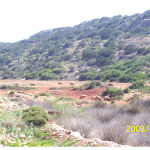 |
Figure 1:
|
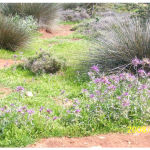 |
Figure 2: |
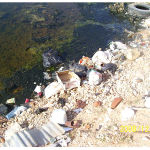 |
Figure 3:
|
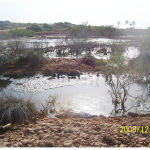 |
Figure 4: |
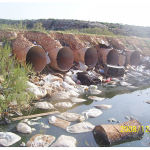 |
Figure 5: |
The Phytochemical screening of the each plant, which collected from
Clean and polluted areas are listed in table 1:
Table 1 : the phytochemical screening of the different plants fractions.
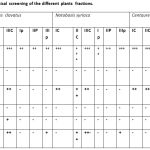 |
Table 1 : the phytochemical screening of the different plants fractions.
|
C= plant collected from clean area, P = plant collected from polluted area
TLC. Investigation of the each plant fractions, which collected from clean and polluted areas are listed in table 2:
Table 2: the TLC. Investigation of the different plant fractions.
| A.C. | Unicycles clavatus
RF |
Notobasis syriaca
RF |
|||||||||
| 1c | 2c | 3c | 1p | 2p | 3p | IC
1c |
2c | 3c | 1p | 2p | |
|
System I Pet.ether : Ether [1:1] |
0.1
0.15 0.2 0.3 0.4 0.45 0.56 o.6’ 0.8 |
0.1
0.2 0.26 0.35 .88 |
0.17
0.23 0.35 0.65 0.68 0.72 0.74 o.77 0.83 |
0.17
0.23 o.27 o.29 0.89 |
|||||||
| :System2
ether 100% |
0.2
0.25 0.28 0.35 0.4 0.54 .087 |
0.14
o.15 o.2 0.35 0.38 |
– | – | o.34
0.38 o.56 0.63 0.69 0.73 |
– | – | 0.13
o.15 o.56 0.63 0.82 |
|||
| :System 3
CH3 CL : MeOH [8:2]
|
0.1
o.14 0.18 0.22 0.28 0.3 0.46 |
– | 0.1
0. 24 0.3 0.78 |
0.21
0.26 0.29 0.43 0.67 o.81 |
– | – | |||||
The Table 2: show the following:
The number of the spots in clean plant extracts is more than polluted plant extracts. This may be due to the polluted material in water adsorbed by plant effect on the biosynthesis of different active constituents .
The appearance of different compounds with different Rf in both extracts.
We need a further investigation to isolate and identify these compounds.
GLC. Investigation of the volatile constituents
GLC. Investigation of the volatile constituents of plants which collected from clean and polluted areas are listed in table 3:
Table 3 : the GLC. investigation of the volatile constituent of different plants.
| Unicycles clavatus | Notobasis syriaca | |||
| c. | p. | c. | p. | |
| No. of peaks | 40 | 5 | 47 | 8 |
Conclusions
From the above results, it is clear that, the pollution effects on the number and amount of the different compounds, this due to the pollution affect on the biosynthesis of different secondary metabolite5-9
The different of active constituents in the same plants which collected from clean area and polluted one. Leads us to do a further investigation to isolate and identify these compounds.
References
- Alscher RG, Donahue JL & Cramer CL (1997). Reactive oxygen species and antioxidants: relationships in green cells. Physiol Plant.
- Kendrick, J.B., E.F. Darly, J.T. Middieton and A.O. Paulus, 1956.Plant response to polluted air: Specific effects of air pollutants on plants vary according to plant species and modifying internal and external factors. California Agric., 10:9-15.
- Bortnick SM & Stetzer SL (2002). Sampling frequency guidance for ambient air toxics monitoring. J Air Waste Manage Assoc 52:
- Burbulis IE, Iacobucci M & Shirley BW (1996). Null mutation in the fi rst enzyme of fl avonoid biosynthesis does not affect male fertility in Arabidopsis. Plant Cell 8: 1013-1025.
- Campos M, Markham KR, Mitchell KA & Proenca da Cunha A ,An approach to the characterization of bee pollens via their fl avonoid/phenolic profiles.
- Phytochem. Anal 8: 181-185.
- Chaves N, Escudero JC & Gutiérrez-Merino C (1993). Seasonal variation of exudate of Cistus J Chem Ecol 19: 2577
- Cooper-Driver GA & Bhattacharya M (1998). Role of phenolics in plant evolution. Phytochem 49: 1165-1174.
- Dixon RA. & Paiva NL (1995). Stress-Induced Phenylpropanoid Metabolism. Plant Cell 7: 1085-1097.
- Emberlin J (2000). Th e problems of pollen. Current Medical Literature (CML): Allergy 8: 25-28.







